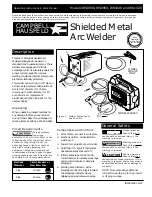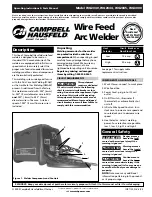
Sc-4
Safety and Compliance
Safety
cUttINg cAN cAUSE FIRE oR EXPloSIoN
Fire prevention
•
Make sure the cutting area is safe before doing any cutting. Keep a
fire extinguisher nearby.
•
Remove all flammables within 35 feet (10 m) of the cutting area.
•
Quench hot metal or allow it to cool before handling or before letting
it touch combustible materials.
•
Never cut containers with potentially flammable materials inside –
they must be emptied and properly cleaned first.
•
Ventilate potentially flammable atmospheres before cutting.
•
When cutting with oxygen as the plasma gas, an exhaust ventilation
system is required.
Explosion prevention
•
Do not use the plasma system if explosive dust or vapors may be
present.
•
Do not cut pressurized cylinders, pipes, or any closed containers.
•
Do not cut containers that have held combustible materials.
wARNINg
Explosion Hazard
Argon-Hydrogen and Methane
Hydrogen and methane are flammable gases that present an explosion
hazard. Keep flames away from cylinders and hoses that contain
methane or hydrogen mixtures. Keep flames and sparks away from the
torch when using methane or argon-hydrogen plasma.
wARNINg
Explosion Hazard
Underwater Cutting with Fuel Gases
Containing Hydrogen
•
Do not cut underwater with fuel gases containing hydrogen.
•
Cutting underwater with fuel gases containing hydrogen can result
in an explosive condition that can detonate during plasma cutting
operations.
wARNINg
Explosion Hazard
Hydrogen Detonation with Aluminum Cutting
When you use a plasma torch to cut aluminum alloys under water
or on a water table, a chemical reaction between the water and the
workpiece, parts, fine particles, or molten aluminum droplets generates
significantly more hydrogen gas than occurs with other metals. This
hydrogen gas may get trapped under the workpiece. If exposed to
oxygen or air, the plasma arc or a spark from any source can ignite this
trapped hydrogen gas, causing an explosion that may result in death,
personal injury, loss of property, or equipment damage.
Consult with the table manufacturer and other experts prior to cutting
aluminum to implement a risk assessment and mitigation plan that
eliminates the risk of detonation by preventing hydrogen accumulation.
Also, make sure that the water table, fume extraction (ventilation), and
other parts of the cutting system have been designed with aluminum
cutting in mind.
Do not cut aluminum alloys underwater or on a water table
unless you can prevent the accumulation of hydrogen gas.
Note:
With proper mitigation, most aluminum alloys can be plasma cut
on a water table. An exception is aluminum-lithium alloys.
Never cut
aluminum-lithium alloys in the presence of water.
Contact your
aluminum supplier for additional safety information regarding hazards
associated with aluminum-lithium alloys.
MAcHINE MotIoN cAN cAUSE INJURy
When an original equipment manufacturer (OEM) makes a cutting system by combining Hypertherm equipment with other equipment, the
end-use customer and the OEM are responsible for providing protection against the hazardous moving parts of this cutting system. However,
we advise the following to prevent operator injury and equipment damage:
•
Read and follow the instruction manual provided by the OEM.
•
Maintain a restricted-access area larger than the maximum
movement range of the cutting system’s moving parts.
•
Where there is a risk of collision, do not allow personnel or
equipment near the cutting system’s moving parts.
•
Avoid accidental contact with the CNC touchscreen or joystick.
Accidental contact can activate commands and result in unintended
motion.
•
Do not service or clean the machinery during operation.
•
If servicing is required, enable the safety interlock or disconnect and
lock out/tag out power to disable the motors and prevent motion.
•
Allow only qualified personnel to operate, maintain, and service the
machinery.
Summary of Contents for HyPerformance HPR130XD
Page 1: ...HyPerformance Plasma HPR130XD Auto gas Instruction manual 806330 Revision 3 ...
Page 16: ...Table of Contents viii HPR130XD Auto Gas 806330 ...
Page 26: ...Specifications 2 2 HPR130XD Auto Gas 806330 ...
Page 38: ...Specifications 2 14 HPR130XD Auto Gas 806330 ...
Page 48: ...Installation 3 10 HPR130XD Auto Gas 806330 ...
Page 59: ...Installation HPR130XD Auto Gas 806330 3 21 1X1 J103 J300 Female Male 5 6 5 6 3X1 3X2 3X3 3X4 ...
Page 94: ...Installation 3 56 HPR130XD Auto Gas 806330 ...
Page 101: ...Operation HPR130XD Auto Gas 806330 Revision 2 4 7 Diagnostics screen ...
Page 102: ...Operation 4 8 HPR130XD Auto Gas 806330 Revision 2 Test screen ...
Page 103: ...Operation HPR130XD Auto Gas 806330 Revision 2 4 9 Cut chart screen ...
Page 152: ...Operation 4 58 HPR130XD Auto Gas 806330 Revision 2 ...
Page 236: ...7 4 HPR130XD Auto Gas 806330 Discrete output functionality ...
Page 294: ...Appendix B CNC Interface Protocol b 28 HPR130XD Auto Gas 806330 Revision 1 ...
Page 302: ...4 HPR130XD Auto Gas 806330 ...
















































